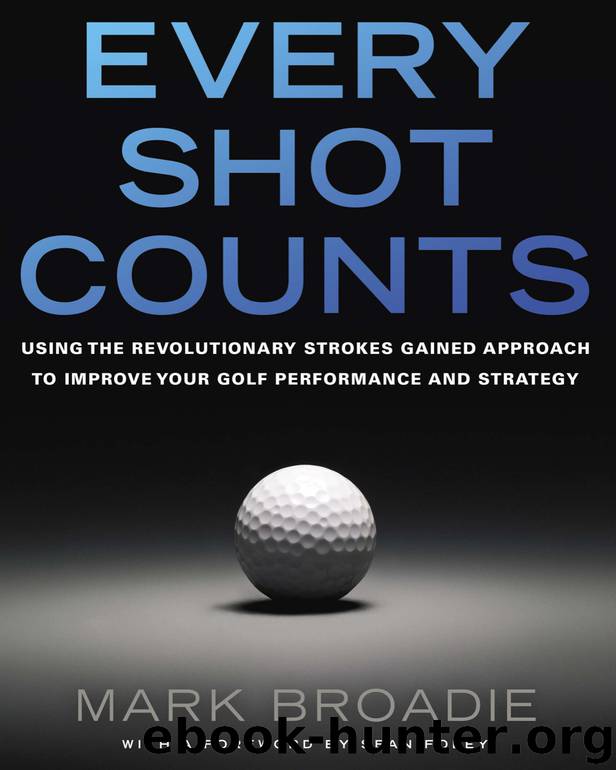Every Shot Counts by Mark Broadie

Author:Mark Broadie
Language: eng
Format: epub
Publisher: Penguin Group US
Published: 2014-03-06T05:00:00+00:00
Measuring iron play using strokes gained approach (SGA)
The “approach shot” category includes all shots over 100 yards from the hole, except for tee shots on par-four and par-five holes.9 Pros hit an average of 18 of these shots per round. That compares to just under 14 tee shots on par-four and par-five holes, 10 short-game shots, and 29 putts per round. Let’s rank pros based on their approach shot performance.
To begin, let’s consider the play of Mr. Steadypro and Mr. Wildpro on a 190-yard par-three hole on two tournament days. Mr. Steadypro hit the green both days, and his average distance to the hole was 30 feet. Mr. Wildpro hit the green one out of two days, and his average distance to the hole was 40 feet. Whose shots were better?
Hitting a green is better than missing. Hitting it closer to the hole is usually better than hitting it farther from the hole. It would appear that Mr. Steadypro’s tee shots were better than Mr. Wildpro’s. But wait! Mr. Steadypro had two 30-foot putts. Pros take an average of four strokes to finish both holes from there. Mr. Wildpro hit one tee shot to two feet and another into the sand 26 yards from the hole. From two feet on the green, the average for pros to finish is one. From 26 yards in the sand, the average for pros to finish is 2.6 strokes (they get up and down about 40% of the time). Pros take an average of 3.6 strokes to finish out the two holes from Mr. Wildpro’s shot locations. According to my strokes gained calculations, Mr. Wildpro gained 0.4 strokes on his tee shots against Mr. Steadypro, even though he hit fewer greens and his proximity to the hole was worse.
How can it be that Mr. Wildpro’s performance was better, when he hit fewer greens and his shots were farther from the hole? It’s another example of the importance of nonlinearity that we learned from Johan Jensen and his Jensen’s inequality. In this case, the math reveals that one great shot and one poor shot are better than two middling shots.
Ranking the approach shot performance of golfers based on greens hit or proximity to the hole is problematic because of the nonlinearity problem. It’s hard to combine greens hit, expressed in percent, with proximity to the hole, expressed in feet. It’s hard to understand true performance when a golfer ranks high on greens hit and low on proximity to the hole or vice versa. The strokes gained method overcomes these problems by measuring the quality of each approach shot in the same unit of strokes and then averaging the results. Strokes gained for each approach shot takes into account how far the shot finished from the hole and whether it finished in the fairway, rough, or sand, or on the green.
Table 6.2 shows the top 40 PGA Tour golfers from 2004 through 2012 ranked by strokes gained approach (SGA) per round. The leader in SGA is Tiger Woods, who gained 1.
Download
This site does not store any files on its server. We only index and link to content provided by other sites. Please contact the content providers to delete copyright contents if any and email us, we'll remove relevant links or contents immediately.
In a Sunburned Country by Bill Bryson(2947)
Annapurna by Maurice Herzog(2839)
How to Read Nature by Tristan Gooley(2665)
Dangerous Girls by Haas Abigail(2469)
The Lost Art of Reading Nature's Signs by Tristan Gooley(2283)
SAS Survival Handbook by John 'Lofty' Wiseman(2258)
In the Woods by Tana French(1996)
Food and Water in an Emergency by Food & Water In An Emergency(1991)
The Stranger in the Woods by Michael Finkel(1923)
Guns, Germs and Steel by Diamond Jared(1883)
Everest the Cruel Way by Joe Tasker(1827)
Backpacker the Complete Guide to Backpacking by Backpacker Magazine(1815)
Sea Survival Handbook by Keith Colwell(1794)
Ultimate Navigation Manual by Lyle Brotherton(1767)
Trail Magic by Trevelyan Quest Edwards & Hazel Edwards(1760)
Wild: From Lost to Found on the Pacific Crest Trail by Cheryl Strayed(1736)
Birds of the Pacific Northwest by Shewey John; Blount Tim;(1604)
Welcome to the Goddamn Ice Cube by Blair Braverman(1601)
Portland: Including the Coast, Mounts Hood and St. Helens, and the Santiam River by Paul Gerald(1581)
